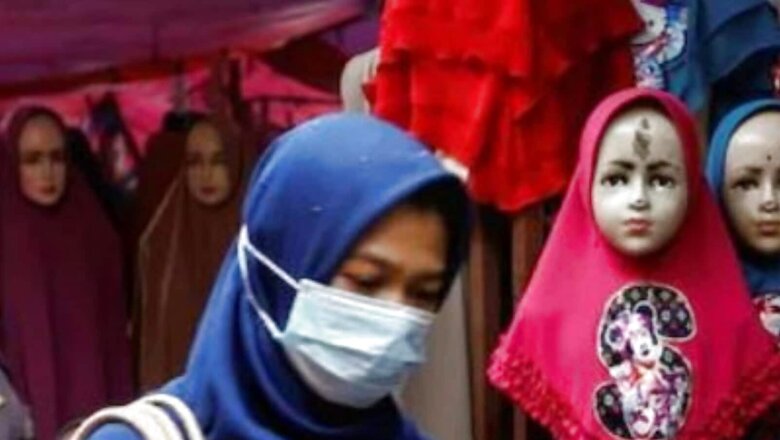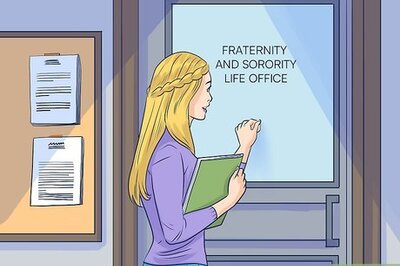
views
Karnataka has been rocked by protests over government school mandate that prohibits wearing of hijab by Muslim women students in classrooms as it violates common uniform policy of these schools. On the face of it, the mandate may appear as violative of the freedom granted by the Constitution of India — the “choice” or freedom of a woman to wear whatever she wants, including hijab, and that “education of girls” should be the priority and it should not be hindered by what she decides to wear in her pursuit of studies.
All of these may appear very convincing arguments but they are being voiced from a vantage point — of living in a secular society. The same seemingly convincing narrative just falls flat when it is applied to Muslim-majority enclaves like Kashmir Valley.
There is a concept of modesty in Islam, which has been interpreted for Muslim women differently in different parts of the world depending on local culture, climate and traditions. The Middle Eastern notions of “hijab” and “niqab” that have now invaded all Muslim societies across the world, including Kashmir Valley and rest of India, are only a 30-year-old import and were not part of the costume culture of Muslim communities in South Asia. There was only “burqa”, as the most extreme form of body veil prevalent in Indian subcontinent, but its use was limited and restricted to mostly older women or women from elite upper caste Ashraf Muslim families, such as Syeds.
An average Pasmanda caste working Muslim woman from Kashmir to Kerala and from Gujarat to Bengal wore their own version of modest religious Muslim coverings, which varied from covering their head with dupattas, sarees or in case of Kashmir Valley, a distinct head scarf. The kind of “hijab” and “niqab” that we see today, with the younger generation of Muslim girls wearing them across India, is an alien attire, which has got nothing to do with our local Muslim culture of Kashmir or Karnataka. It is part of the orthodox and puritanical Muslim traditions of the Middle East.
In Kashmir Valley, exponents of Kashmiri Muslim culture have been fighting the forced cultural imposition of Arabic costume culture on Kashmiri society for many years. Our Kashmiri Muslim mothers were gracefully and modestly dressed in accordance with Islamic norms even before these Middle Eastern conservative veils appeared on the scene three decades ago.
I am also not comfortable with the misuse of the argument of constitutional freedom to justify encouragement to wearing “hijab” or “niqab” because our Indian Constitution does not encourage us to promote orthodoxy, social and cultural conservatism and religious puritanism. Our Indian Constitution encourages us to strive for modernity, progressiveness and scientific temper and “hijab” or “niqab” does not pass these benchmarks.
It is also strange that those who are defending “hijab” as constitutional right of an Indian Muslim woman stay shamelessly quiet on many other things that various Muslim communities all over India continue to do, which can also be considered “unconstitutional” and yet their practice remains unabated. In Kashmir, for example, Kashmiri Muslims practice untouchability against Hindus and Sikhs. We have different utensils for non-Muslims in our homes. We discriminate against Pasmanda caste Muslims and treat them with indignity and disdain. We even treat our Muslim Gujjars and Bakarwals worse than animals. Isn’t there a saying that if a Kashmiri Muslim comes across a snake and a Gujjar Muslim, he should kill the Gujjar Muslim and not the snake. Is this behaviour constitutional? Or even Islamic?
Muslims in Karnataka who are stubbornly defending “hijab” and “niqab” should come to Kashmir Valley and see how the penetration of these orthodox, conservative and regressive cultural practices have destroyed Kashmir’s relaxed, secular, joyful and happy-go-lucky culture. Kashmir has suffered some of the worst impacts of religious orthodoxy and puritanism and Kashmiri Muslim women have been the worst victims. Such is the pathetic condition of orthodoxy in Kashmir that in 2014 when devastating floods hit Kashmir Valley, all orthodox religious muftis and maulanas blamed it on young Kashmiri Muslim girls wearing jeans. Is this the Karnataka that Kannada Muslims aspire to see for themselves?
Finally, I also want to touch upon the oft-used argument of “choice of a Muslim woman” to justify encouragement to wearing “hijab” and “niqab”. The much-misused word “choice” is no choice but a “manufactured choice” that is a result of years of subjective, biased, orthodox and unsecular upbringing that most Muslim children in modern Muslim families with heavy influence of Arabic culture are brought upon. If a young Muslim woman raised in such non-secular setting later wears “hijab” or “niqab” as per what the world perceives as her “choice”, it is not really her choice, but a “manufactured choice” borne out of orthodox upbringing.
ALSO READ | Lesson from Iran: When It Starts with Hijab, It Doesn’t End Too Well for Women Empowerment
I am especially disappointed with the liberal Hindus, who may think that they are supporting a young Indian Muslim woman’s “choice” to wear whatever she desires to wear, but are actually unwittingly causing severe damage to Indian Muslim society, preventing it from embracing modernity and progressiveness. Supporting such bigoted and regressive measures also makes the position/stand taken by a tiny minority of progressive and liberal Muslims like us, who are fighting to uproot Muslim orthodoxy in our communities, untenable.
I wish the Muslim community of Karnataka would have shown even 1 per cent of enthusiasm in dealing with issues of caste discrimination among Kannada Muslims, including the pathetic living conditions of Dalit Kannada Muslim community, the “Mehtars”, who continue to live in abject poverty and are forced to work as manual scavengers to date.
In the end, I would also like to state that Babasaheb Ambedkar, who drafted the Constitution of India, was a very progressive man who stood for equal rights of all women, including Muslims. He was specifically against practice of veils adorned by Muslim Indian woman. Nothing could be more tragic than to see Muslim community in Karnataka using the excuse of Constitution to justify “hijab” and “niqab”.
Javed Beigh is General Secretary, People’s Democratic Front (Secular). His can be followed @javedbeigh. The views expressed by the author are his own and do not represent the stand of this publication.
Read all the Latest Opinions here



















Comments
0 comment